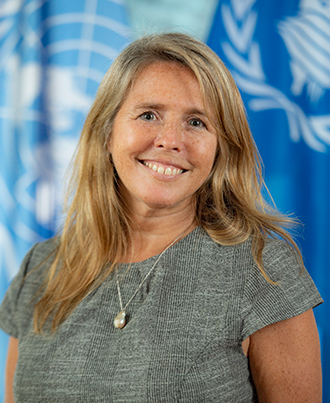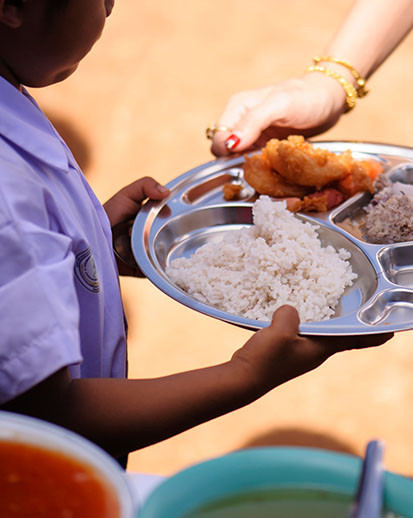Closing the micronutrient gap for 800 million people
Through our partnerships in the public and private sectors, we work to create affordable, aspirational and accessible nutritional solutions that can help keep the world’s growing population healthy.
Two billion people worldwide currently suffer from a deficiency of key micronutrients, a condition known as hidden hunger. Its effects can be devastating, leading to mental impairment, poor health (including stunting and wasting), low productivity, and even death. Its adverse effects on child health and survival are particularly acute, resulting in serious physical and cognitive consequences. Even mild to moderate deficiencies can affect a person’s well-being and development. In addition to affecting human health, hidden hunger can curtail socioeconomic development, particularly in low- and middle-income countries.
As part of our new strategic Food System Commitments, we have undertaken to enable the closure of this micronutrient gap for 800 million people currently suffering from hidden hunger by 2030. The fortification of rice with essential micronutrients is an element in this commitment. It is one of the most effective, safe and cost-efficient solutions to address micronutrient deficiencies.
The rationale for fortifying rice
Rice is one of the most commonly eaten foods in the world, providing more than 20% of global calorie intake. White rice, which is milled prior to cooking, is significantly more popular than brown or unmilled rice. Approximately 480 million metric tons of milled rice is produced annually worldwide. As a staple food for over half the global population, rice offers a good and affordable source of energy. However, rice itself does not contain significant amounts of most micronutrients. Additionally, the milling process that produces the commonly-consumed white rice removes both the fat- and nutrient-rich bran layers from the rice ears, further reducing the rice grains’ nutritional value. White rice is therefore a relatively nutritionally poor staple.
The process for fortifying rice
Rice can be made more nutritious by adding vitamins, minerals and other micronutrients to replenish nutrient content lost in the milling process and reinforce its nutritional value. Fortified rice can be adapted to meet specific nutritional needs and can be made to resemble different rice varieties.
There are various methods to make rice more nutritious post-harvest, and DSM has developed a robust proprietary technology in the form of hot or warm extrusion. This technology has been shown by numerous clinical studies to be effective in helping to combat micronutrient deficiencies.
Broken rice grains are ground into rice flour, then mixed with water and the required nutrients to produce a dough. The fortified dough is then passed through an extruder to produce the fortified kernels, which are then blended with regular rice, typically at a dosage rate of approximately 1%. The temperature at which the extrusion takes place determines whether it is described as hot or warm extrusion and has an influence on the firmness of the produced fortified kernels.
Our solutions
DSM is involved at every stage of the rice fortification value chain. Our activities range from engaging in joint advocacy efforts together with partners and customers to encourage demand for fortified rice, through product innovation and development, all the way to the provision of micronutrient fortificants and technical assistance.
A significant body of evidence demonstrates the role of rice fortification in reducing nutrient deficiencies and deficiency-related diseases (e.g., anemia), improving cognition, and supporting immune function. We help private- and public-sector allies – including brand owners, governments, non-governmental organizations (NGOs), UN agencies, donors and employers — to develop and integrate nutritional interventions that help improve nutrition and strengthen immunity for at-risk populations.
Extruded fortified rice kernels are produced in rice-producing and -exporting countries such as India, Thailand and Costa Rica. These vitamin-enriched rice grains are generally then blended into unfortified, locally produced rice. We also support local rice millers with our expertise in formulation, blending and quality control.
Fortified rice can now be found in many parts of the world. It features in public health programs such as school meals for children, social safety nets and meals for workers, and is also available via commercial retail outlets.
Do you know?
Fortified rice has the potential to be a game-changer in the fight against malnutrition. Do you know how much rice is fortified in the world today?
1% of the rice consumed worldwide
Our impact
The DSM-WFP partnership has invested in activities to expand the production, availability and consumption of fortified rice in 20 countries, reaching over 15 million people annually through social safety nets (SSNs).
More than 45 metric tons of fortified rice to date have been distributed through in-kind donations. The DSM-WFP partnership has additionally helped more than 70 small and medium-sized enterprises (SMEs) in Bangladesh to build their capacity for producing fortified rice, directly supporting local food producers and processors. As a result, more than 7 million people in Bangladesh now have access to fortified rice via social safety nets.
Stronger together
Our partnership with the United Nations World Food Programme (WFP), one of several current partnerships in the field of food fortification, operates under the banner ‘Improving Nutrition, Improving Lives’. It aims to leverage multiple channels to reach as many WFP beneficiaries and consumers as possible with affordable, high-quality fortified rice over the coming years. These channels include WFP direct food distributions and social protection programs such as school feeding and government food distribution schemes.
The DSM-WFP partnership draws on our respective organizations’ complementary competences and networks, bringing us closer to our shared goal of ending hidden hunger and allowing us to achieve more together through co-creation than we would be able to do alone. As DSM, we bring our scientific expertise and innovation capacity in developing nutrition solutions and products, as well as our financial resources and private-sector network to the partnership. WFP brings its extensive operational presence, its deep understanding of local contexts, its national and local networks, and its focus on vulnerable populations in countries where vitamin and mineral deficiencies are most prevalent.
Ever since its inception in 2007, the DSM-WFP partnership has made significant contributions to ending malnutrition worldwide. Scaling up rice fortification has been a key focus of the partnership since 2016.
Disclaimer: WFP does not endorse any product or service.

“The damaging effects of the COVID-19 pandemic have made the need for such public health interventions greater than ever.”Allison Oman Lawi
How we support the SDGs
Our partnership with the World Food Programme in the field of rice fortification supports the attainment of UN Sustainable Development Goal 2.
2
2 – End hunger, achieve food security and improved nutrition and promote sustainable agriculture
Our partnership makes an important contribution to helping ensure that all people, in particular the poor and people in vulnerable situations, including infants, have access to safe, nutritious and sufficient food all year round (SDG Target 2.1.). It also contributes to achieving, by 2025, the internationally agreed targets on stunting and wasting in children under 5 years of age, and addresses the nutritional needs of adolescent girls, pregnant and lactating women and older persons (SDG Target 2.2.).





